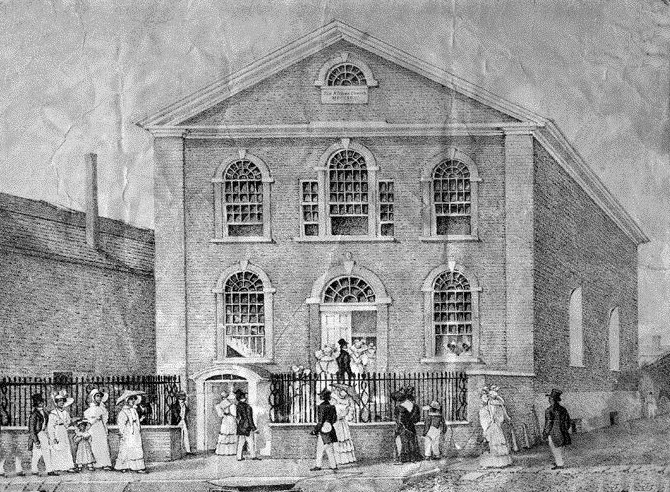Who is this Absalom Jones that Episcopalians celebrate each year in February?
Born into slavery in Delaware in 1746, Absalom Jones began to teach himself to read and write as a teenager, buying books with pennies he received from visitors to his master’s home. While still in his teens, he was sold away from his family to a new owner in Philadelphia. He clerked in his owner’s store during the day and worked for himself and attended an all-Black school at night.

Portrait of Absalom Jones, 1810, from the Delaware Art Museum.
The life of Absalom Jones was marked by vision, faith, focus, discipline, patience and selflessness. At any point in life he could have made a wanton decision to take the easy route, to rebel against his condition, or to look out for himself first. In the face of adversity, Absalom Jones never did that. Putting his faith completely in God, he took the long view and exercised the discipline, patience and focus to get himself there.
As he continued to work as a clerk in the store, he asked to buy his way to freedom, but his master consistently declined. At the age of 24, he married Mary King from a neighboring estate and they started their family. By saving his money, accepting donations and seeking loans, he was able to purchase his wife’s freedom, thereby assuring that his children would be born free. (Children took the status of their mother.) Finally, after much insistence, by 1784, when Jones was 38 years old, he obtained freedom from slavery.
Looking at Jones’ life, we see a steady, patient, faithful, honest and determined man of dignity – a man who commands respect. Consider the love and selflessness he displayed in delivering the dignity of freedom to his wife and children even as he himself continued in the degradation of slavery.
His Life as a Priest
Absalom Jones was a parishioner and lay minister at St. George’s Methodist Episcopal Church of Philadelphia in 1786. The Methodist Episcopal Church admitted persons of all races, and St. George’s was an interracial congregation. Due to the efforts of Jones and fellow lay minister Richard Allen, the Black membership of the church increased tenfold.
Sadly, one Sunday racism raised its ugly head in the church when the Africans were nudged from their knees and told that they could no longer worship shoulder to shoulder with the White congregants, but had to worship from the balcony. When they completed their prayer, Jones and Allen led the Africans out of the church, never to return.
Some people would fuss or argue or appeal–certainly making their voices heard and demanding that they be treated as equals. Instead, Jones displayed a complete sense of his own inherent, God-given right to freedom and equality; he did not have to beg for it.
Jones and Allen then founded the Free African Society (FAS), a benevolent organization where Africans could save money and receive support for family emergencies, hard times, illness or death. Jones and Allen held religious services at FAS, which was aligned with the Episcopal Church. They considered turning it into a religious institution that would represent pride in African heritage and be a response to racism in White churches, but that did not happen.
Although the abolitionists of Philadelphia desired to end slavery, racism was not so quick to die. White Philadelphians segregated Africans at churches and in cemeteries. Jones and Allen, through FAS, opened schools, churches and cemeteries to serve Philadelphia’s African American residents. FAS also opposed the new and growing “colonization” idea that Africans, once free, should leave the United States and repatriate to Sierra Leone on the African continent.

The African Episcopal Church of St. Thomas was formed in 1792 and continues to thrive today.
In 1793, with the outbreak of yellow fever in Philadelphia, many who could afford it fled to their country homes. Jones remained, and used the services of FAS to provide comfort and financial aid to the sick until, unfortunately, the organization became insolvent and had to disband by late 1794. But in 1792, FAS had founded the African Episcopal Church of St. Thomas, and Jones became its first leader. He was made a deacon in 1795, and ordained a priest in 1802, becoming the first African American priest in the Episcopal Church – and in any major White denomination in the United States. The founding documents of St. Thomas described their purpose: “to arise out of the dust and shake ourselves, and throw off that servile fear, that the habit of oppression and bondage trained us up in.”
Jones continued to dedicate his life and his gifts to the freedom and dignity of his people. With the passage of the Fugitive Slave Act of 1793, Jones took part in the first group of African Americans to petition the U.S. Congress against the cruelty and brutality of the Act, especially the criminal practice of kidnapping free Blacks and selling them into slavery. On his own on two separate occasions, Jones drafted petitions to Congress seeking to free kidnapped African American freedmen.
Perhaps what has made Absalom Jones’ name a household word among Episcopalians is that spirit of stern determination, the show of faith in God’s power to change the circumstance, and the patience to live into God’s time. Absalom Jones died on February 13, 1818. The African Episcopal Church of St. Thomas continues as a thriving church to this day, carrying on the legacy of a rich African heritage. Its 225th anniversary was celebrated in 2019.

